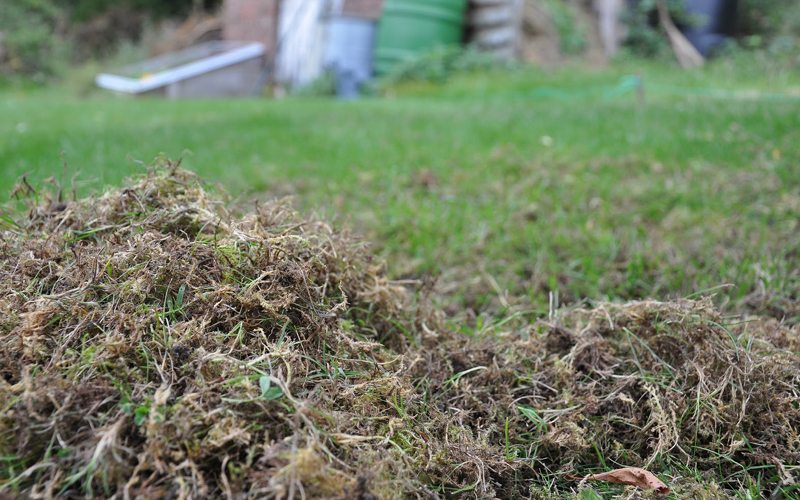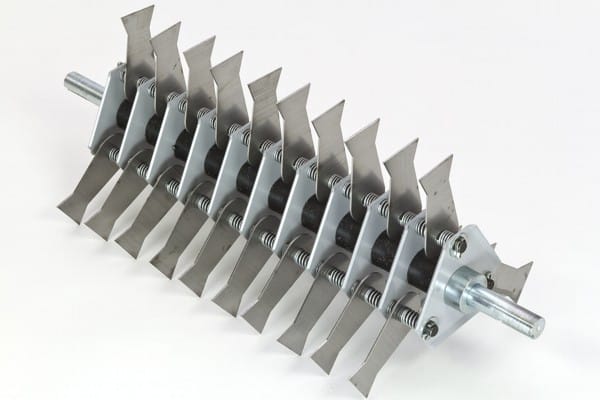

Scarification is a process best described as a thorough mechanical heavy raking of a lawn.
The machine we use has a series of sharp tungsten blades that rotate at high speed and cut vertically into the turf. The depth can be adjusted to remove as much or as little thatch as required. This machine and process should not be confused with the type of machine typically available on the domestic market, which is more of a lawn rake, has much less power and limited depth penetration.
What is the objective of Scarification?
The main objective of Scarification is to reduce the level of thatch in a lawn by allowing air and water to flow freely between the surface of the lawn and the soil level. To break down naturally, thatch requires a good amount of airflow and water flow. This increase in airflow will also create unfavourable conditions for moss and fungal diseases to grow, whilst improving the overall health of the grass plant.
When and why does my lawn need scarifying?
A lawn that has developed thatch and moss needs to be scarified to remove as much of this material as possible, allowing the grass space to grow, and the movement of air around the surface of the lawn to increase. Scarifying should be carried out at a time when the grass is growing slowly as this will allow it to recover from this rigorous process. Autumn through to spring is usually the best time of year for scarifying.
Scarifying can be carried out throughout the year to help thicken up sparse lawns by splitting the stolons of the grass plant. Scarifying is also useful when preparing the ground for Overseeding and lawn renovation.
How often does my lawn need scarifying?
All lawns are different in their characteristics and it is therefore very difficult to predict how often to scarify. Professional greenkeepers scarify at least once a year, and depending on the quality of lawn you would like, we would recommend including Scarification in your annual lawn care schedule.
There are a number of factors that will affect the frequency required. If a lawn contains large amounts of thatch and/or moss it may need a number of treatments to reduce these down to a manageable level. Different grass types tend to produce more thatch than others and therefore need scarifying more frequently.
What will my lawn look like following Scarification?
The condition of your lawn following Scarification will differ depending on several factors. The depth of the thatch layer and the time of year that Scarification is carried out will have the biggest impact. Most lawns will look a little worse for wear following Scarification.
Scarification carried out in autumn or winter
Lawns that are scarified at this time of year will take some time to recover as the grass plant grows slowly in low temperatures, and doesn’t grow at all in very low temperatures. You should not expect to see a full rejuvenation of your lawn until the following spring. The good news is that you don’t need to do anything during this period as the soil is generally wet enough to ensure the roots and the grass plants remain healthy.
Scarification carried out in spring or summer
Lawns that are scarified in spring or summer will require a little further help to rejuvenate. Generally, we would only carry out such work if we feel the lawn has little chance of improving without it. To help your lawn rejuvenate and ensure the grass plants remain healthy, the soil must remain wet at all times and the lawn must be mown regularly. The more frequently you mow your lawn whilst ensuring the soil remains wet, the quicker your lawn will rejuvenate.
What will happen to the thatch once my lawn is scarified?
Will Scarification remove all of the thatch in my lawn?
This depends on several factors such as the age of the lawn and what we are trying to achieve. Older lawns can cope better with much deeper and intensive scarification, whereas younger lawns will take longer to recover if a very deep scarification is carried out. Most of the scarification services we carry out are classed as “medium” scarification. In general, medium scarification will remove enough thatch to allow any remaining thatch to break down naturally.
Heavier scarification and a 2 pass scarification is also offered, but this would only be in extreme circumstances.
Lawns require a small amount of thatch to remain healthy. Thatch, amongst other things, helps maintain a moderate temperature around the crown of the grass plants, keeping them warm during the colder months.
Will Scarification remove all of the moss in my lawn?
No. Although Scarification does remove a large proportion of moss from the lawn, its main purpose is to reduce the home of moss, thatch. Attempting to remove every last bit of moss will only cause long-term damage to the grass plants.
Any moss that is left following Scarification will be controlled with a moss-control treatment. Following an application of moss control, the moss will turn black and break down naturally into the soil. Please do not attempt to remove any more moss following your Scarification treatment, especially if we have applied an overseed or carried out a patch repair or renovation.
Why don't I just control the moss in my lawn using a moss-control treatment each year?
You can. Our moss-control treatments are very effective at killing the moss that is alive in your lawn at the time of treatment. However, this year’s moss is next year’s thatch. When moss is killed and Scarification is not carried out, the dead moss simply turns into a home for next year’s moss to flourish in. Scarification breaks this cycle, and makes our moss-control treatments more effective.
Why is better to scarify first, then apply a moss control?
Moss grows upwards from thatch, creating a ‘cushion’ of growth. When a moss control is applied to an unscarified lawn, the soluble application will often not reach the bottom of the moss cushion. It is uneconomical and often ineffective. Scarifying a large portion of moss out first, then scarifying, will enable the moss control to effect the remainder of the moss.
Are you able to scarify my entire lawn?
This really depends on several factors. The machines we use are 19 inches wide, and the blades are on a rotating shaft that is around 16 inches wide. We are unable to scarify areas of lawn (for example, narrow grass pathways) that are narrower than our machines as this is likely to cause damage to the turf.
Lawns’ borders can also pose a problem. The wheels on our machine are around 1.5 inches wide, which means we are unable to scarify all the way up to the edge of a lawn, especially if there is a dip into a flower bed. Experience has shown us that due to Scarification improving the airflow over the entire lawn, moss in the edges of the lawn will soon find it hard to survive and will break down naturally.
What type of scarifier does Green Man Lawn Care use to scarify a lawn?


We use a solid waisted blade that is free to swing on a high speed axle. This is by-far the best type of scarifier to use on domestic lawns as it helps to overcome the most common issues such as uneven ground, and the waist helps the blade hook the thatch away from the lawn.
There are some bare patches on my lawn. What can be done about them?
Scarification can sometimes leave bare patches. They are caused by numerous factors, such as:
1. Uneven ground.
2. A thicker build up of thatch is removed from localised areas throughout the lawn.
3. The grass plants have been allowed to dry out in those areas prior to scarification.
4. Areas that have suffered from fungal disease and need to rejuvenate.
These patches need time to rejuvenate, and in some cases require patch repair. We would recommend overseeding to help reduce the need for patch repair, but you should be aware that overseeding is not a method most associated with repairing bare patches.
What are the different levels of scarification offered by Green Man Lawn Care?
Each lawn is different, so we offer different levels of scarification depending on what is required.
1. Medium Scarification – This is the most common level of scarification and is carried out on lawns with a minimal to medium level of thatch. Medium Scarification is a single pass of the scarifier travelling at a speed between 3kph and 5kph.
2. Heavy Scarification – Heavy scarification is required when there is a thicker than normal level of thatch. We set the scarifier to reach a lower depth and in most cases will slow down the travel speed over the lawn.
3. Very Heavy Scarification – A very heavy scarification is required on lawns where the thatch layer is excessive, and the grass plants are using the thatch layer as their growth medium. The scarifier is set very low and the travel speed is slower than normal in an attempt to reach soil level.
4. Double Pass Scarification – Double scarification is required on lawns that have an extremely excessive amount of thatch. The thatch layer is often an accumulation of decades of thatch build up. It is common for the grass plants to be rooted in to such a thatch layer, and double scarification will leave a lawn looking extremely bare.
